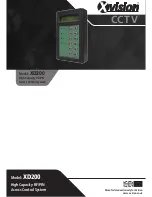
3. Figure 1-11 shows a clamp-on ammeter, the
most common type of current measurement described
in this manual . Be sure to zero out the meter before
using and make sure the jaws are completely closed
during use. Place the meter jaws around the cable, with
the arrow points in the direction of current flow, to
measure all the current.
1-20.
MEASURING RESISTANCE WITH THE
OHMMETER.
The ohmmeter is used to measure
electrical resistance. The unit of measure is the ohm.
The ohmmeter is connected across the unit or portion
of the circuit for which the resistance is to be measured.
The ohmmeter has its own power source, usually a
small battery, which causes current to flow through the
circuit to be measured. Since the meter power source
(battery) voltage is known, the current is inversely
proportional to the resistance of the circuit. The meter
automatically computes and reads out the resistance:
E (voltage) divided by I (current) equals R (resistance).
1-21. OHMMETER SELECTION.
As with voltmeters
and ammeters, both analog (needle) and digital
ohmmeters are available. Digital ohmmeters are
preferred for the same reasons that the other
instruments are. Additionally, most digital ohmmeters
have a diode scale which can be used to test diodes and
transistors.
1-22.
OHMMETER USE.
Figures 1-12 through
1-14 illustrate some typical uses of the ohmmeter.
CAUTION
Typical heavy duty electrical system voltage
(12 or 24 volts) could produce a current flow
through the ohmmeter that could damage
the meter. Never connect an ohmmeter to a
circuit that is under voltage.
Always
disconnect the battery ground cable before
using the ohmmeter.
1-23.
As shown in Figures 1-12 and 1-13, the ohmmeter
is also useful as a continuity meter. An infinite
ohmmeter reading (See Figure 1-12) indicates an open
circuit (no continuity). A very low (approaching zero)
reading (See Figure 1-13) indicates continuity. Figure
1-14 illustrates some digital ohmmeter applications.
NOTE
Most digital meters have a diode scale (
)
which must be used to check diodes or
transistors rather than the ohm scale.
1-24. APPLYING AN ELECTRICAL LOAD WITH
A CARBON PILE.
(See Figure 1-15) The carbon pile
is a variable resistor designed to carry high current. A
carbon pile, along with a voltmeter and ammeter, is
normally an integral part of a modern battery tester.
In addition to load testing batteries, carbon piles are
used to test starter and alternator circuits.
1-5
Figure 1-11. Clamp-On Type Ammeter
DP-1011
CLAMP-ON
TYPE AMMETER
OHMMETER
OPEN
DP-1012
Figure 1-12. Analog Ohmmeter Showing Open
Circuit
TRUCK
FRAME
TOUCHING
GROUND
OHMMETER
Figure 1-13. Analog Ohmmeter Showing
Continuity
DP-1013
new diagnostic manual 4/5/05 9:47 AM Page 1-5
This document, and more, is available for download from Martin's Marine Engineering Page - www.dieselduck.net








































